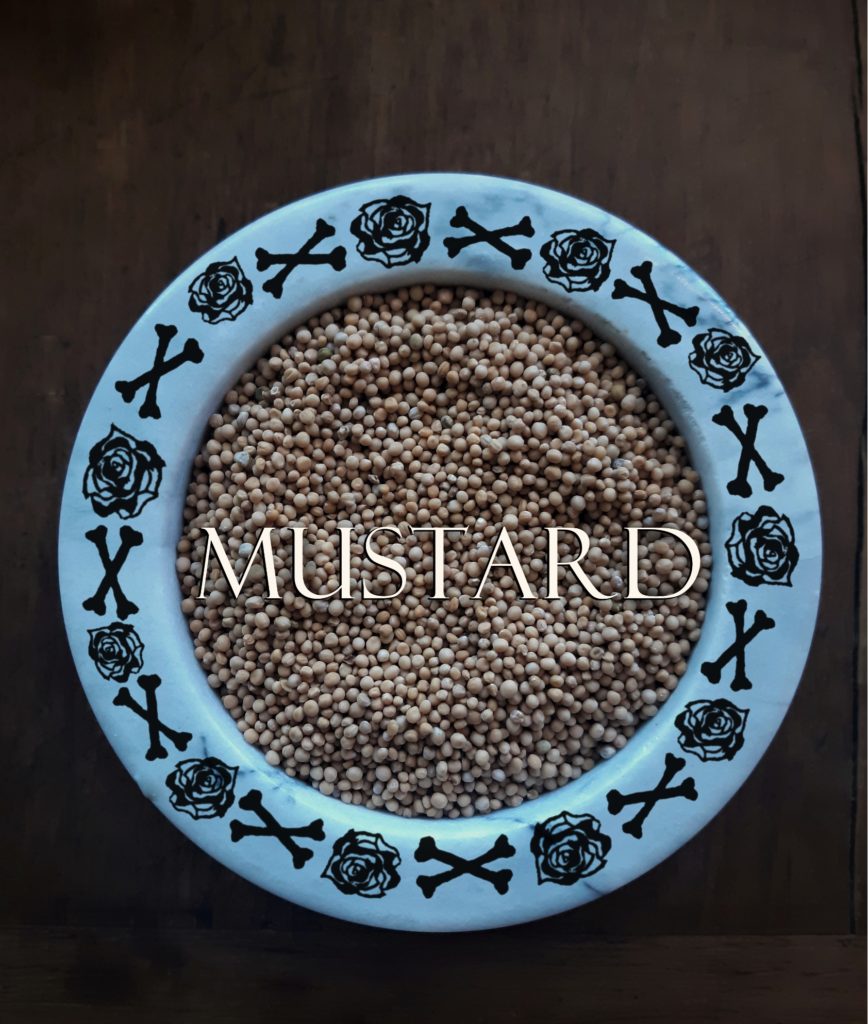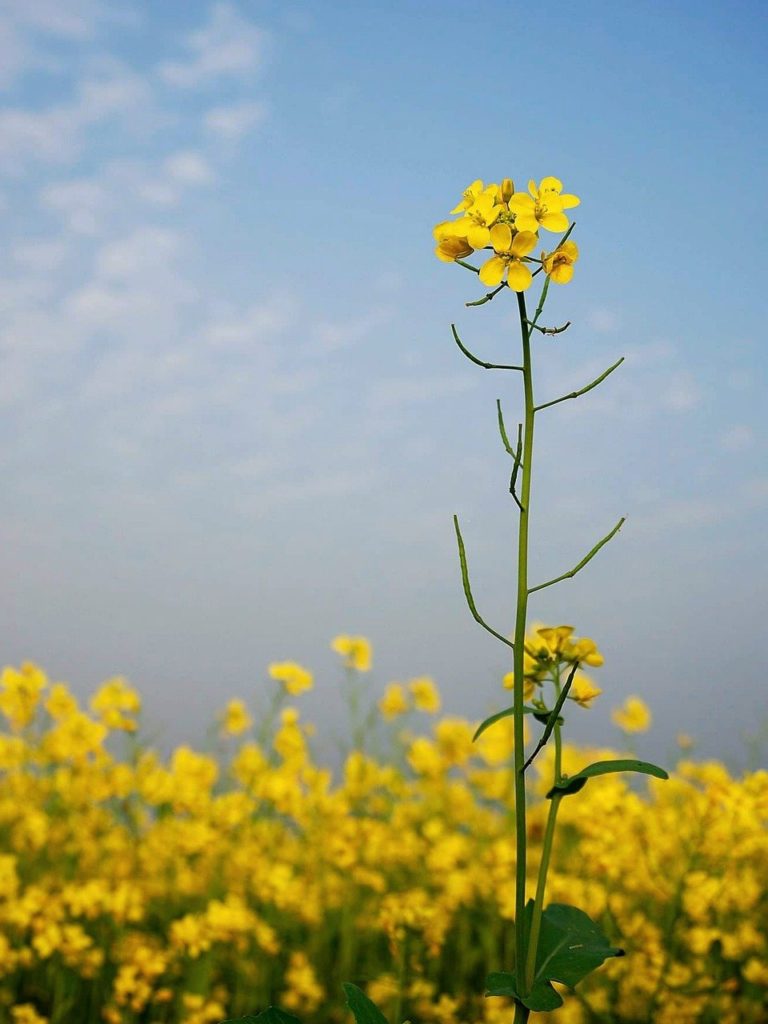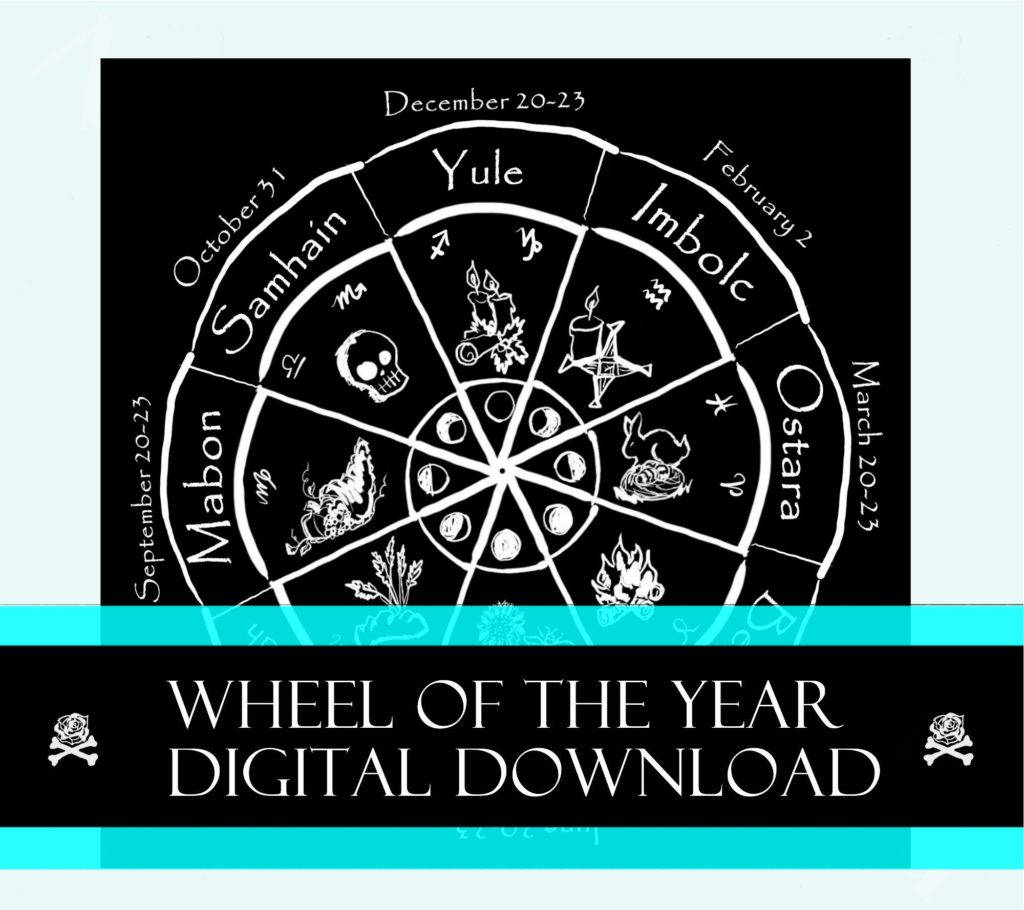
Christians know the mustard seed as an analogy for growing faith.
Hedge witches know the mustard seed as an analogy for amphibian eyeballs.
This Th-HERBS-day, we honor mustard (Brassica spp.).
It’s a member of the cabbage/mustard (Brassicaceae) family, formerly known as the Cruciferae family.
Cruciferae stems from the root word crucifer or crucifix and is made up of plants whose flowers form a cross-like pattern.
Mustard is known as “the spice of nations” because it is present in every culture.
In early European herbal medicine, the mustard seed was famously referred to as the “Eye of Newt.”
Today, this term is associated with stereotypically depicted witches in Hollywood horror films.
It has even made cameos in the 1960s Addams Family series, which often portrayed imagery associated with witches.
Ironically, the newt or salamander represents the fire elements in sectors of Paganism which aligns with mustard’s ruler Mars.
This ambiguous herb in witchcraft is quite the spicey spirit that very much lives up to its fiery element in witchery.
We know mustard today to be a popular condiment, but its use spreads farther in witchcraft than at the hotdog stand.

The History of Mustard
The mustards are an edible species that include vegetables such as broccoli, turnips, watercress, kale, cauliflower, and radishes.
Ancient Greeks and Romans regarded mustard as an important herb for both medicine and food.
Leaves were commonly used as potherbs and salads, while seeds were ground into early versions of the condiment known today.
Medicinally, it was used to increase blood flow and relieve digestion.
Early U.S settlers and Native Americans both used mustard for food and medicines.
Ground into a fine powder, black mustard seed was mixed with animal fats to form topical pastes for rheumatism and headaches.
At one time, mustard seeds were even recommended as a form of treatment for seizures and toothaches.
Mustard was one of the first mass-marketed food products in history thanks to Coleman’s Mustard established in the 1800s.
During the Klondike Gold Rush, Coleman’s marketed their mustard powder as a remedy to beat the cold by using it for “hot mustard baths.”
In the 1920s, “The Mustard Club” was established as a marketing gimmick which surprisingly had many people wanting to join.
There was even a film created to help promote the club and Coleman’s Mustard powder called “The Order of the Bath.”
In French cuisine, many varieties of mustard are used to create some of the most flavorful iconic dishes in fine dining.
France had at one time been the only source of table mustard and was especially famous for its Dijon mustard.
Dijon mustard was thought to only be considered authentic if it was produced in the Dijon region of the country.
ARES MARS Greek God of War Statue Sculpture Figure Handmade Greece 6.69 inches

Mustard Witchery and Spirit
“Eye of Newt” seems to be more of an appropriate name for mustard, as its connection to the animal indicates its fiery essence.
The power of mustard’s energetic presence can be deciphered by the color variation of the seed.
Mustard’s Mars influence can either be subtle in the lighter-colored seed or overpowering in the spicier dark-colored seeds.
The rest of the herb’s parts also carry the energetic characteristics of its ruling planet, but the energy is most concentrated in the seed.
Mustard has a spirit that loves to warm up the vibes around it and encourage strength, courage, and reinforce relations.
Instinctively, it creates bridges between things that are separated by promoting fellowship, inspiration, progression, and reassurance.
It can be effective in spell crafting for business partnerships, contracts, building permits, or organizing focus.
Mustard shines when worked into spells revolving around unpredictability because it tactically carries out your orders with confidence.
You can always use a bit of mustard seed as an afterthought to emphasize confidence and conviction in your craft.
However, when working with herbs ruled by planets that can be dominated by Mars, such as the Moon or Venus, it’s advised to sparsely use lighter-colored seeds.
Too much concentrated Mars energy can distort a primarily Venus-ruled intention and actually backfire and adversely affect your magic.
Using Venus-ruled herbs in an attempt to manipulate situations ruled by Mars can have unfavorable results if you throw an herb like mustard in the mix,
This can even manifest physically when strongly concentrated mustard comes into contact with Venus-ruled body parts like the skin.
Even though the skin is ruled by Venus, it is also the border to the body, which Mars cannot help but focus all of its energy on dominating and conquering.
When applied to the skin, pure mustard can cause a warming sensation, but if it is left on too long, it can cause blisters to form, ruining its beautiful texture.
This is very much how the spice of mustard can work energetically if not thoughtfully paired with a harmonious herb or intention.
If you are doing some intense protective magick, black mustard seed will surely add the power needed to get the job done.
Also, be wary of adding mustard to full moon spells and rituals, it can disrupt emotions.
ENJOY THE DELICIOUS SAVORA MUSTARD COOK WAITERS FRENCH FOOD VINTAGE POSTER REPRO

Mustard’s Energetic Properties
This list of mustard’s properties is an extremely helpful guide to assist you in spell crafting and rituals.
The energy of the herb is heightened when planned carefully with corresponding days, seasons, zodiacs, etc.
Here are 18 energetic properties associated with mustard:
1. Planet: Mars
2. Zodiac Sign: Aries
3. House: 1st
4. Element: Fire
5. Gender Energy: Masculine
6. Chakra: Manipura/Solar Plexis (Yellow)
7. Archangel: Cameal
8. Deity: Ares (Greek), Thor (Norse), Laran (Etruscan)
9. Sabbat: Beltane
10. Season: Spring
11. Day: Tuesday
12. Body: Head, External Sex Organs, Muscular System, Face, Left Ear, Sense of Taste, Bladder
13. Rune: Fehu, Uruz
14. Numerology: 9
15. Fae: Salamander
16. Major Arcana: The Emperor, The Tower, Death
17. Minor Arcana: Wands
18. Cartomancy: Diamonds

Cultivating Mustard
Mustard lives up to its Mars energy as a protective companion plant in the garden.
Some researchers found that wild mustard can reduce cabbage aphids when planted with brussels sprouts and collard greens.
Anecdotally, mustard has also been said to stimulate the growth of fruit trees and prevent root rot.
However, this ambitious plant tends to dominate the space of the garden and will take over because it self-sows.
Mustard is easily grown from seeds and can be sown from early spring to early fall.
The young plants are strong enough to survive the winter and will continue to grow and ripen seeds by the following fall season.
To plant, sow the seeds in a sunny spot roughly 1/8 inches into well-drained soil.
Mustards require lots of food so keeping the soil full of compost or fertilizer is recommended.
When harvesting the seeds, wait until the pods have turned brown and before they split.
Place them on trays and cover with a dense cloth to ripen.
Once the pods have split and shattered, clean the seeds and store them in air-tight containers in a dark space away from direct light.
Happy Th-HERBS-day!

